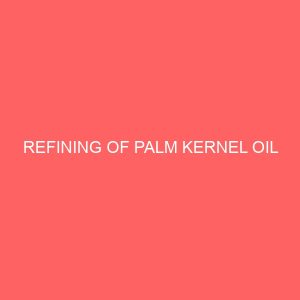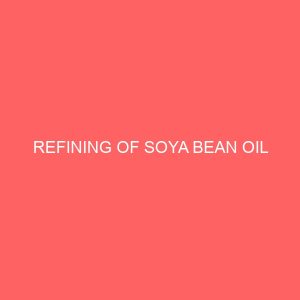EFFECT OF PARTICLE SIZE ON OIL YIELD USING SCENT BEAN SEED (‘OZAKI’)
ABSTRACT
This project was done to extract and characterize bean oil according to their particle sizes. The experiment was carried out using scent bean i.e. Ozaki, Ijilizior Azamu as sample. The oils were extracted by solvent extraction /leaching extraction using nhexane. Proximate analysis was carried out to obtain percentage moisture content, ash content, total oil content, protein content and carbohydrate content of the extracted oils. From observation, it was noticed that as the diameter of the sieve decreased, the quantity of oil obtained increased.
CHAPTER ONE
1.0. INTRODUCTION
1.1. BACKGROUND OF THE STUDY
There has been an increase in the world production of oilseeds over the last thirty years Murphy, 1994; this would appear to be related to the increasing demand for oilseed products and byproducts as oilseeds are primarily grown for their oil and meal.
Oils from most edible oilseeds are used in the food industry, though there is growing emphasis on industrial utilization as feedstock for several industries with about 80 of the world production of vegetable oils for human consumption. The remaining 20 utilization is between animal and chemical industries Murphy, 1994.
According to Rajagopal et al. 2005, biooils from oilseeds are used as Straight Vegetable Oil SVO or as biodiesel trans esterified oil depending on type of engine and level of blend of the oil; scent bean oil i.e. Ozaki, Ijiliji, or Azamu is found mainly in the SouthEast of Nigeria and is not an exception. This phenomenon has created a school of thought that it is better to use oilseeds as biofuel, which will lessen the competition for fossil fuels, which are not renewable. Fossil fuels are not only costly in terms of price but are also costly to the environment as they degrade land, pollute water and cause a general destabilization of the ecosystem with global warming as an end result. Furthermore, crude oil wields sociopolitical power that often dictates the pace of economic growth in specific locations, especially nonoil producing nations.
1.2. Problem Statement
Many plants have been identified as sources of oil, with some of the plant species and their oil extracted and used as medicines and food. However, very few of these species have their oil characteristics determined.
Because of the high demand of oils for various purposes including medicinal, perfumery, soap making, insecticides et al. Imported oils are very expensive to meet the demands of our local consumer industries; therefore, it becomes necessary to source and synthesize these oils locally. Since these oils can be produced locally, it gives no reason for their importation or at least should reduce the rate at which these oils are imported and give attention to local production.
1.3. OBJECTIVES OF THE STUDY
The purpose of this study is to
a. Find the percentage composition of oil in the bean seed
b. To determine the effect of particle size on the yield of the oil.
1.4. SIGNIFICANCE OF THE STUDY
Exploitation of fruits and seeds as a source of oil can help to reduce oil costs by diversifying the sources for this commodity. Data generated from this study will benefit industries for production of oils for various purposes.
In addition the content and composition of fatty acids of plant seed oils can serve as plants taxonomic markers.
1.5. JUSTIFICATION OF THE RESEARCH
Some factors and benefits of bean Ozaki, Ijiliji or Azamu oil make the research worthwhile;
1 The bean is readily available.
2 Oil from this particular bean is medicinal and applicable in pharmaceutical industries.
3 Small scale industries coming up as a result of oil extraction can reduce unemployment.
4 It can attract foreign exchange earnings for Nigeria.
Original price was: ₦3,200.00.₦3,000.00Current price is: ₦3,000.00.








Reviews
There are no reviews yet.